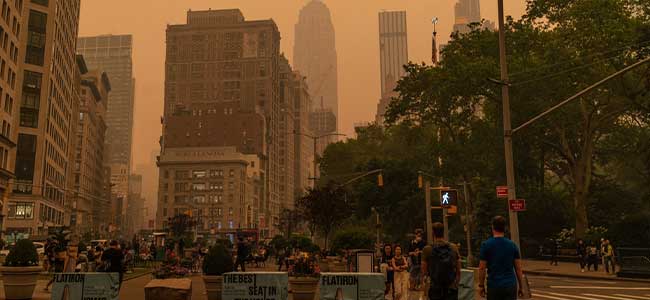
Exploring Outdoor Worker Safety in Wildfire Smoke
As areas of the U.S. continue to see an unhealthy air quality index, what can be done to ensure people required to work outdoors remain safe?
- By Alex Saurman
- Jun 09, 2023
In the past few days, Canadian wildfire smoke has caused the air quality in many regions of the U.S. to become unhealthy.
On June 7, New York City Mayor Eric Adams said that the Air Quality Index (AQI), which measures air pollution using a scale of 0, representing good air quality, to 500, representing hazardous air quality, had reached 484. New York and other areas, like Washington D.C., Baltimore and Philadelphia, issued air quality health advisories and alerts.
While many residents have been advised to stay indoors and wear masks if they go outside, what effects does wildfire smoke have on people, like outdoor workers, who are exposed to it?
Though not much is known about the effects of wildfire smoke specifically on outdoor workers, those exposed to wildfire smoke may experience eye irritation, coughing, pneumonia, per the National Institute for Occupational Safety and Health, or more severe side effects such as chest pain, heart attacks and lung complications, according to the Washington State Department of Labor & Industries.
“Right now, only two of 50 states—California and Oregon—have specific safety rules which protect workers from wildfire smoke,” said Marcy Goldstein-Gelb, co-executive director of The National Council of Occupational Safety and Health (National COSH), in a recently published news release. Washington State filed proposed permanent wildfire smoke rules for workers in May 2023.
In its news release, National COSH recommends two steps workers can take to ensure their safety around certain conditions like wildfire smoke: watch the AQI and based on the reading, “advocate with your employer for proper protections.”
The AQI is broken up into six categories that include AQI range, health concern and color:
- 0 to 50, Good, Green
- 51 to 100, Moderate, Yellow
- 101 to 150, Unhealthy for Sensitive Groups, Orange
- 151 to 200, Unhealthy, Red
- 201 to 300, Very Unhealthy, Purple
- 301 and up, Hazardous, Maroon
When the AQI falls in a specific category, general actions—not specifically for workers and employers—that should be considered, according to the Environmental Protection Agency, include:
- Green: No need to take action
- Yellow: Unless you’re “unusually sensitive,” no need to take action
- Orange: Taking extra precautions and staying alert for those who are sensitive or have asthma or heart disease
- Red: Shortening outdoor activity time, lowering the activity’s physical demands and resting. For people who are sensitive, continue the activity indoors or delay it. According to a news release from Washington D.C. Mayor Muriel Bowser, air filters should also be considered, and sensitive people can utilize masks when outside.
- Purple: Shortening the activity, going indoors or delaying it. Sensitive people should “avoid all physical activity outdoors.” Per Bowser’s news release, consider utilizing an “N95 or KN95 equivalent” mask when outside.
- Maroon: Staying inside and not performing outdoor activities that are physical.
To check the AQI in your area, visit airnow.com.
Photo credit: lev radin / Shutterstock.com
June 9, 2023 Correction: National COSH issued a correction in its news release. The quote from Goldstein-Gelb has been updated to reflect the correction.